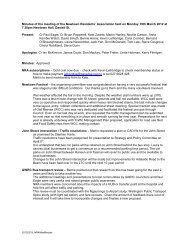Draft Town Belt Management Plan - Wellington City Council
Draft Town Belt Management Plan - Wellington City Council
Draft Town Belt Management Plan - Wellington City Council
Create successful ePaper yourself
Turn your PDF publications into a flip-book with our unique Google optimized e-Paper software.
Moera: Moe-ra (Moe-i-ra 54 or Moe-i-te-ra 55 ), was “a Ngāti Awa kainga, possibly palisaded”. It was<br />
situated where Maraama Crescent now is, near the road to Brooklyn and Ohiro. It was so named<br />
because the kainga caught the rays of the early sun, which shone on the hamlet even before the<br />
people woke up in the morning.” 56 This area was already used by Te Aro Māori as a cultivation,<br />
consequently the McCleverty Award reconfirmed land to them that should already have been<br />
reserved under the Crown Grant.<br />
Omaroro: The Omaroro cultivation area was located on steeply sloping ground, perhaps terraced,<br />
on a spur of the Turangarere hills at Brooklyn facing the north-east within an area now part of the<br />
<strong>Town</strong> <strong>Belt</strong>. This area became the Vogeltown Block and was awarded to Wi Tako Ngatata of<br />
Kumutoto Pā. It appears that this and other land in what was designated as <strong>Town</strong> <strong>Belt</strong> was<br />
purchased from the Kumutoto people, including Wi Tako, in 1852.<br />
The Omaroro Award also covered earlier cultivations belonging to the people at Te Aro. The<br />
original area was larger than the awarded area. This award left them worse off as only the northern<br />
end was reaffirmed in Te Aro ownership and the full cultivation area was never reserved. “It is<br />
likely that because it impinged upon the adjoining section the cultivation area ceased to be used as<br />
a cultivation reserve and was leased out for cash return.” 57 The lessee eventually purchased the<br />
freehold to this property, which had ceased to be of real value to the pā as a cultivation for<br />
sustainable needs.<br />
On 7 October 1847 Te Aro Māori were awarded a further 50 acres as “The Natives of Te Aro having<br />
represented that within the limits of the land assigned in the deed, no kumara plantations can be<br />
made …” 58 This half-section was sold in 1863 as the population of the pā declined and the viability<br />
of cultivating at such a distance on such poor land became unsustainable.<br />
The name of this block should perhaps be Omaruru after the native owl.<br />
Tinakore and Orangikaupapa: Eighty acres of the <strong>Town</strong> <strong>Belt</strong> were awarded by McCleverty to<br />
Pipitea Māori. It is known that the <strong>Town</strong> <strong>Belt</strong> contained Māori cultivations although it is not known<br />
if they were on these lands awarded. The 80 acres of the <strong>Town</strong> <strong>Belt</strong> were in the Tinakori range,<br />
towards Wadestown, made up of Orangikaupapa, Tinakore South and Tinakore North. Much of<br />
this land was leased by Māori to a Mr O’Neill for a very low rental as Māori had stopped using the<br />
land.<br />
The Orangikaupapa block was subdivided into 14 lots. In 1873 the Orangikaupapa lots were all<br />
given on long-term leases. The first sale of the lots was in 1877.<br />
Kumutoto Kainga – including the Botanic Garden: <strong>Town</strong> <strong>Belt</strong> land was treated by the<br />
Crown as Crown land and its ‘exchange’ to Kumutoto was seen as an act of generosity by the<br />
Crown. The land was subsequently used as cultivation land – some 62 acres of Māori cultivations<br />
were already situated on this land prior to this, and these were guaranteed by Fitzroy 59 .<br />
In October 1852 the entire <strong>Town</strong> <strong>Belt</strong> awarded to Kumutoto was purchased by the Government:<br />
196<br />
We the undersigned having accepted the sum of 160 pounds sterling, the receipt whereof is<br />
hereby acknowledged in payment for the block of land containing fifty-two acres, three<br />
roods and thirty perches, the boundaries which are described in the within deed, reconvey<br />
the same to the Governor-in-Chief upon behalf of Her Majesty Queen Victoria and<br />
renounce all rights and title and interest in the same forever.<br />
Signed: Wiremu Tako for himself and for Tamati Paratene<br />
Paora Hukiki for himself and Raniera<br />
54 Cited by Neville Gilmore, Historian for <strong>Wellington</strong> Tenths Trust<br />
55 Adkin, G Leslie: The Great Harbour of Tara 1959, p42<br />
56 Best, Elsdon 1911. Māori Notebook no 13 in WAI 145 I9(a) p85<br />
57 http://www.wcl.govt.nz/maori/wellington/ngawahiaro.html<br />
58 WAI 145 10(a) Doc 3 McCleverty Deeds, p12<br />
59 H Hansen Turton, ‘<strong>Wellington</strong> Tenths: Turton’s Epitome of Official Documents relative to Native Affairs and Land<br />
Purchases in the North Island of New Zealand, p D12<br />
<strong>Draft</strong> <strong>Town</strong> <strong>Belt</strong> <strong>Management</strong> <strong>Plan</strong> October 2012





